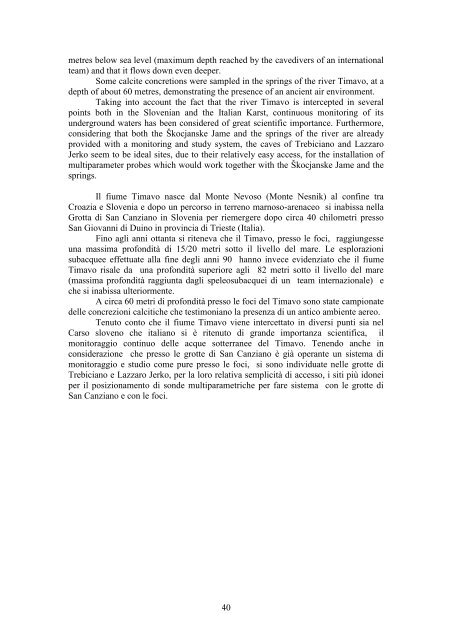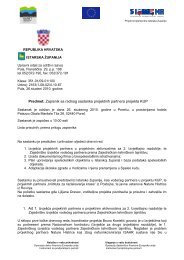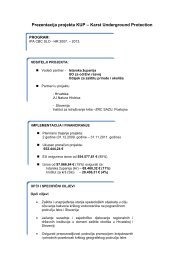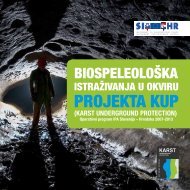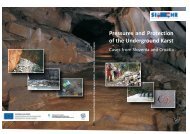prvi hrvatski speleološki kongres - KARST underground protection
prvi hrvatski speleološki kongres - KARST underground protection
prvi hrvatski speleološki kongres - KARST underground protection
You also want an ePaper? Increase the reach of your titles
YUMPU automatically turns print PDFs into web optimized ePapers that Google loves.
metres below sea level (maximum depth reached by the cavedivers of an international<br />
team) and that it flows down even deeper.<br />
Some calcite concretions were sampled in the springs of the river Timavo, at a<br />
depth of about 60 metres, demonstrating the presence of an ancient air environment.<br />
Taking into account the fact that the river Timavo is intercepted in several<br />
points both in the Slovenian and the Italian Karst, continuous monitoring of its<br />
<strong>underground</strong> waters has been considered of great scientific importance. Furthermore,<br />
considering that both the Škocjanske Jame and the springs of the river are already<br />
provided with a monitoring and study system, the caves of Trebiciano and Lazzaro<br />
Jerko seem to be ideal sites, due to their relatively easy access, for the installation of<br />
multiparameter probes which would work together with the Škocjanske Jame and the<br />
springs.<br />
Il fiume Timavo nasce dal Monte Nevoso (Monte Nesnik) al confine tra<br />
Croazia e Slovenia e dopo un percorso in terreno marnoso-arenaceo si inabissa nella<br />
Grotta di San Canziano in Slovenia per riemergere dopo circa 40 chilometri presso<br />
San Giovanni di Duino in provincia di Trieste (Italia).<br />
Fino agli anni ottanta si riteneva che il Timavo, presso le foci, raggiungesse<br />
una massima profondità di 15/20 metri sotto il livello del mare. Le esplorazioni<br />
subacquee effettuate alla fine degli anni 90 hanno invece evidenziato che il fiume<br />
Timavo risale da una profondità superiore agli 82 metri sotto il livello del mare<br />
(massima profondità raggiunta dagli speleosubacquei di un team internazionale) e<br />
che si inabissa ulteriormente.<br />
A circa 60 metri di profondità presso le foci del Timavo sono state campionate<br />
delle concrezioni calcitiche che testimoniano la presenza di un antico ambiente aereo.<br />
Tenuto conto che il fiume Timavo viene intercettato in diversi punti sia nel<br />
Carso sloveno che italiano si è ritenuto di grande importanza scientifica, il<br />
monitoraggio continuo delle acque sotterranee del Timavo. Tenendo anche in<br />
considerazione che presso le grotte di San Canziano è già operante un sistema di<br />
monitoraggio e studio come pure presso le foci, si sono individuate nelle grotte di<br />
Trebiciano e Lazzaro Jerko, per la loro relativa semplicità di accesso, i siti più idonei<br />
per il posizionamento di sonde multiparametriche per fare sistema con le grotte di<br />
San Canziano e con le foci.<br />
40


